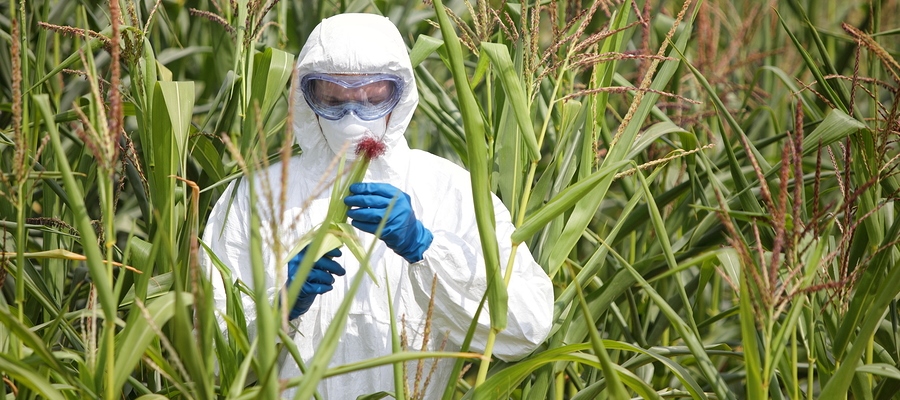
Whether or not to use genetically modified foods is not a new issue. These foods have been in existence for many years – first arriving on the scene in the late 1990s. What studies have shown about these foods and the potential damage they can cause to humans and animals alike isn’t good news.
With the desire to create foods from plants and animals that are thought to be superior to more natural breeding methods, genetically modified foods were introduced.
These are also known as bioengineered foods. Whenever you’re putting anything into your body, you need to know its source and how it can benefit or damage your physical health.
What does Genetically Modified Mean?
These are foods in which the genetic makeup has been altered. This alteration is caused by the implantation of other genes from other foods or animals, from viruses, from insects and even from the bacteria normally found in the soil.
These modifications are placed in the original product and it forces cell changes that are safe or healthy for humans to eat. It used to be that breeders of plants or animals took part in cross breeding of various species to create a better, sturdier hybrid version of two originals.
The way it worked was that the breeder chose animals or plants that had highly sought after features. They then mixed these to create what they wanted in the hopes of gaining a new product. It was assumed that this mixture would create a more superior animal or plant. This type of cross breeding was relatively harmless.
However, those who work in biotechnology have taken the idea several steps forward and use a lab to mix genes from all types of products.
The goal for this type of genetic alteration was done because it was thought that by creating genetically modified foods, the food would not only taste better – but that it would also be better for people to eat.
Another thought was that these foods could be created to withstand issues that were known to damage other plants or animals. Some of these issues were pests, poor water supply, weather related issues and diseases.
It was thought that by mixing one gene with another gene, a plant would be created that could then naturally fend off pests. Instead of having to use chemical based pesticides to protect the plant, the plant could protect itself by creating its own natural pesticide.
It was also thought that if genes could be injected into plants in order to create plants that could withstand a chemical onslaught from pesticides, that the plant would be safe – but the pesky weeds trying to grow in the same area would die off.
By being able to protect itself, it was thought that the crops of these plants had a higher chance of reaching maturity, cutting down on loss to growers and ensuring enough food supply for an ever growing world population.
The proponents of genetically modified foods also thought that these foods would have a faster growth cycle. This faster cycle would mean that foods could be produced and delivered with less cost to the manufacturer.
What are Some of the Genetically Modified Foods?
You might be surprised at the foods that have already undergone genetic changes. There are a lot more than you think. You’ll find these foods in natural, canned, bagged or frozen varieties.
In fact, studies have shown that more than half of the everyday foods consumers buy at the store to feed themselves and their families has been genetically modified.
As a consumer, you might believe that any changes to the food products you consume would be clearly labeled with this information – especially if anything in the product could cause health issues for you. It should be clearly labeled so that all consumers have the choice in whether or not to buy them.
But this isn’t the case. Foods that have been altered through the means of genetic changes don’t have to be labeled with this information – even though they can cause adverse health issues.
In fact, on the FDA website, it states that the labeling of these foods is on a volunteer basis. Many manufacturers have chosen not to identify the food as containing any genetic modification. So, you could buy and eat these foods and not even know it.
That’s why it’s important that you know which foods have been genetically modified. By avoiding these foods, you can prevent long-term problems that have been associated with these genetic changes.
One of the biggest foods known to have been genetically modified is corn. You’ll find this in many foods that humans eat – but you’ll also find that it’s in animal food as well. Almost 90% of foods that contain a corn product have been genetically modified.
You only need to check your kitchen to see examples of this. If you have cookies or crackers or foods that contain corn syrup, then you have a food that’s been altered.
Besides corn, soy is also genetically modified. And the percentage of soy that’s been genetically modified is even greater than the percentage of corn. Almost 95% of all soy has been altered. If a food contains the words hydrogenated oils, then it’s been modified.
This modified form of soy is even found in baby formula and the fact that it’s been genetically altered isn’t on the label, so parents don’t even realize they’re giving this to their babies. Though soy has been touted as healthy and even good for consumption, the truth is that since most soy has been genetically modified, it’s extremely unhealthy – especially for babies.
Studies have shown that consuming altered soy can lead to the development of allergies and malnutrition. It’s also been known to cause digestion and immune problems.
You’ll find that soy isn’t the only genetically modified ingredient that parents unknowingly feed to their babies. If it has corn in it, then it’s probably been genetically altered.
What some people have done to try to avoid eating genetically modified foods is to purchase only organic foods. But even organic foods are not always 100% free of these alterations.
How is Genetically Modified Food Affecting Your Health?
When you eat foods that have been genetically modified, you’re at a greater risk of having a potential allergic reaction – especially if you already have allergies. Genetically modified foods have been known to cause allergies in consumers.
An allergic reaction to something happens as a result of your body’s immune system attacking a foreign body in order to try to keep you safe. Since humans were never meant to eat these altered food products, the body’s immune system kicks in and attacks these foods once they’re in your system.
Not only does this process then cause an allergic reaction, but you can also run the risk of having a greater reaction. This can happen because some of the genetically modified foods can be modified with foods that a person is extremely allergic to.
You can come into contact with trace elements when a food such as a peanut’s genetic makeup is inserted into another food. The genes in a food or animal product are designed to work in a way that’s best for that plant or animal.
Even though there may be genetic flaws, these flaws only impact the original plant or animal. It doesn’t affect a human.
However, when trying to create a superior product by modification, the genes can be altered in such a way that they become dangerous to a human’s long-term health.
Eating genetically modified foods increase your chances of developing certain types of cancer. Two of the largest risks of cancers associated with these changed foods are stomach and colon cancers.
These cancers can happen because some of the modified DNA is infected with a virus. This virus then causes changes to the modified DNA. And, what’s so scary about these changes is that your stomach and digestive tract can’t break this DNA down and remove it from your body.
That means this rogue DNA, which wasn’t present in the food until it was genetically modified, can cause harm to your body without you even knowing that it’s happening.
And studies have been conducted that prove that genetically modified foods do cause some pretty serious health risks when they’re consumed. In one study involving rats, it was proven that digestion problems occur.
Rats that were given genetically modified foods to eat were found to have intestinal damage and liver problems. A diet that contained these foods also caused death in young rats.
Trying to modify food sources also causes superbugs to flourish. Genetically modified foods have been shown to cause an increase in disease resistant bacteria.
Whenever animals are given large amounts of antibiotics in order to kill germs and to boost production, human health pays the price. What happens is that humans eat these foods with these genetic changes.
The attempt to kill off germs that affected the animals was not one hundred percent successful. Some germs were able to survive the antibiotic. This increases a human’s risk of developing a serious illness that’s resistant to antibiotics and other treatments. The result is the formation of a superbug.
How Genetically Modified Foods Affect the Environment
One of the supposed reasons for creating genetically modified foods was to make a food source that was more resistant to pesticides than normal foods. This didn’t mean that growers stopped using pesticide.
What it meant was that the growers wanted crops that could be sprayed, but the pesticide wouldn’t kill the crop – just the pest or weeds. But, this wasn’t always successful – and some of the pests became resistant to the pesticide.
Because of this, even stronger pesticides known as neonicotinoids had to be used. This has a dangerous side effect for humans. When people eat these altered foods treated with the stronger sprays, they’re exposed to the dangerous alterations within the food and also to the pesticides that the foods were sprayed with.
Thanks to the stronger pesticides on these foods, it also affects the insect world – and in a very negative way. With news reports showing the death of thousands upon thousands of bees, studies showed that exposure to stronger pesticides were thought to be the culprit.
Bees play an essential part in pollinating plants, vegetables and fruits. As the bees die out, the number of bee colonies will begin to dwindle. This could result in a food shortage that affects both national and global farmers.
Another way that genetically modified foods affect the environment is through cross contamination. An example of this would be two cornfields not far from one another. In one of those cornfields, genetically modified crops are being grown.
In the second field, the corn is not genetically altered. While the second farmer may want to grow organic crops, his supply can become accidentally contaminated by the crops from the genetically modified field. If the soil is contaminated by these organisms, then both farms could become affected.
Pollination is another possibility. Pollen is often blown into the air by the wind. If some spores from genetically altered crops land in the naturally grown field, they could cause contamination. So, even though you might be buying organic food, because of this contamination, your food could still be genetically changed.
Studies have shown that this cross contamination is occurring. If it continues to go on, the world’s food supply could end up genetically modified. All of the changes to the environment because of genetic modification are still not fully understood.
And since the total effect of genetic alterations to foods is still not completely known, there’s a strong risk that the world’s ecosystem could be impaired. Even a small upset – such as millions of bees dying – could cause a ripple effect through the food chain that could result in massive changes to the world’s food supply.
How to Avoid Eating Genetically Modified Foods
Since there are so many foods that contain unhealthy modifications, trying to figure out which foods aren’t altered can be confusing and overwhelming. You want to find ones that are safe and healthy. But once you know what to look for, then shopping for healthy foods won’t be such a hassle.
One of the best ways to avoid genetically modified foods is to buy foods that are organically grown. This means that the food isn’t altered by genetic changes. And unlike genetically altered foods, which are not clearly labeled, organic foods usually do contain a label.
This packaging assures consumers that the item they’re purchasing can be trusted to be organic. Many fruits and vegetables that are sold to consumers in the US are free of any genetic modifications.
However, there do happen to be a few exceptions to this. You’ll want to watch out for foods that can possibly be altered. Look out for sweet corn, papaya, zucchini and summer squash. Some of these foods have been known to have undergone modification.
Papaya that is grown outside the US is usually not genetically altered in any way. But if you happen to purchase papaya that comes from Hawaii, there is a risk that the food was exposed to genetically modified organisms.
At this time, there aren’t any genetically altered fish foods that can be purchased in stores by consumers. However, the companies that are pro genetic modifications are pushing for the approval of genetically altered fish.
Even though fish currently isn’t on the modified list, that doesn’t mean that the ones you buy haven’t been fed a diet that contains genetically modified foods. To avoid this possibility, you’ll want to skip buying the farmed fish.
Instead, what you want to look for is wild fish. You’ll also want to make sure that you read the labels when you buy canned fish. You only want to buy canned fish that’s packed in olive oil or water – since some canned fish may contain oils that have been genetically modified.
When it comes to buying steak or turkey, you want your meats to be organic. Like other organic foods, organic meats are usually labeled. But, just because a meat is labeled as organic doesn’t mean it’s entirely in the clear.
Many growers feed their livestock genetically modified foods, which means you’re still at risk of consuming modified foods. Instead, you want to purchase meat that has been grass fed. This ensures that the meat you’re consuming really is free from genetic changes.


